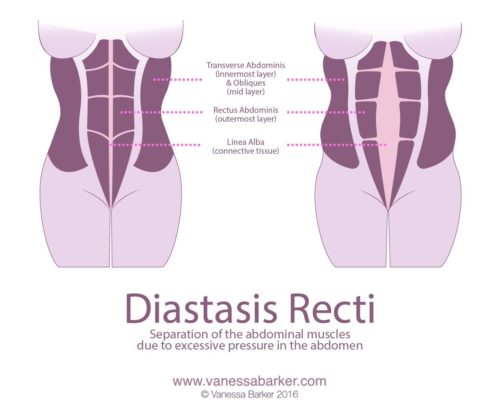You are pregnant. Your bump is growing every day.
But what is going on in the ab-department?
Normally your “six pack” muscles named RECTUS ABDOMINUS are lying in two rows running from your ribs up to your pubic bone and are only seperated by a thin line of connective tissue named the LINEA ALBA.
During pregnancy the Rectus muscles are pushed apart and the distance gradually increases so that the Linea Alba becomes stretched and thin. This seperation is called Diastasis Recti Abdominus, or DRA for short.
In the below sketch from http://www.vanessabarker.com/wp-content/uploads/2015/10/IMG_1624-2.jpg this is illustrated well:
 And even though all pregnancies end up with a DRA, managing it after birth is where the physical therapist comes in, to help nudge the two enstranged muscle bellies back as a functioning unit. If these muscles remain apart, your support in the pelvis and abdomen is affected.
And even though all pregnancies end up with a DRA, managing it after birth is where the physical therapist comes in, to help nudge the two enstranged muscle bellies back as a functioning unit. If these muscles remain apart, your support in the pelvis and abdomen is affected.
The Abdominal muscles work closely together with the pelvic floor muscles to control pressures in your belly. Lifting a baby, coughing, bending, turning – all these activities need good support around the bladder and organs to prevent leakage of urine or sagging down of the pelvic organs.
Up to 60 % of all mothers will have a DRA at 6 weeks after birth. At 12 months after birth this number drops to 32% (Sperstad et al.,2007).
Why we should give attention to DRA
A 2007 study (Sperstad et al.) noted that 66% of the women with DRA had a support- related pelvic floor problem. This means that there is a relationship between the presence of a DRA and other conditions like urinary leakage, leakage of stool and sagging of pelvic organs (prolaps)
Your pelvic floor physiotherapist can do a simple test to diagnose DRA.
With the correct exercises, modification to your daily activities and rehabilitation your two muscle bellies will soon be working together as a unit again.
#regainconnection
#DRArehabilitation


